Live on the homepage now!
Reader Supported News
He’s sued his niece and The New York Times, whose reporting has become part of New York prosecutors’ investigations into his financial dealings, for $100 million.
At the time, though, Trump was busy with other matters, such as letting Saudi Arabia get away with murdering a U.S. resident and, later, laying the groundwork to claim the 2020 election was stolen from him. Now he’s got more time on his hands. And as his legal outlook grows dimmer and dimmer, he’s decided to revisit the issue.
Per NBC News:
Former president Donald Trump filed a $100 million lawsuit Tuesday against his estranged niece, Mary Trump, and The New York Times, claiming they conspired to obtain his tax returns for the paper’s...story on his undisclosed finances. The lawsuit asserts that Mary Trump and three Times reporters—Susanne Craig, David Barstow, and Russell Buettner—were engaged in what the suit calls an “insidious plot” and an “extensive crusade” to obtain Trump’s taxes. “The defendants engaged in an insidious plot to obtain confidential and highly-sensitive records which they exploited for their own benefit and utilized as a means of falsely legitimizing their publicized works,” the lawsuit claims.
Craig, Barstow, and Buettner received a Pulitzer Prize in 2019 for explanatory reporting for their series of stories, which provided the public with an unprecedented look at Trump’s finances. Mary Trump has said she released Trump’s tax returns to the Times in her best-selling 2020 book about her uncle, Too Much and Never Enough: How My Family Created the World’s Most Dangerous Man, and in media interviews, which the lawsuit notes.
The suit was filed in New York State court in Dutchess County, which is where lawyers for the president’s late brother Robert Trump filed an unsuccessful claim to stop the publication of Mary Trump’s book. The 27-page suit alleges [Craig] “relentlessly sought out his niece…and convinced her to smuggle the records out of her attorney’s office and turn them over to The Times.” It added, “Craig, aware that the documents had been derived from the litigation proceedings of the Estate Actions, directed Mary Trump to retrieve the documents from the office of her prior attorney for the Estate Actions, Farrell Fritz, and to ‘smuggle’ them out.”
Additionally, the suit accuses Mary Trump of violating a confidentiality agreement barring her from publicly releasing the details of the family’s finances, claiming Trump’s niece and the reporters were “motivated by a personal vendetta and their desire to gain fame, notoriety, acclaim and a financial windfall” and to “advance their political agenda.”
One key detail that the suit doesn’t mention is that last November, the offices of the New York attorney general and Manhattan district attorney expanded their probes into Trump and his businesses to include suspicious tax write-offs on millions of dollars in consulting fees, some of which, according to a 2020 Times story, appeared to have been paid to Ivanka Trump. That story showed that the “very rich” real estate developer had managed to reduce his taxable income by deducting approximately $26 million in fees to “consultants” as business expenses between 2010 and 2018. While the consultants’ identities were not listed on tax records, some of the fees definitely looked like they’d been paid to his favorite child. As the Times reported:
On a 2017 disclosure [Ivanka Trump] filed when joining the White House as a presidential adviser, she reported receiving payments from a consulting company she co-owned, totaling $747,622, that exactly matched consulting fees claimed as tax deductions by the Trump Organization for hotel projects in Hawaii and Vancouver, British Columbia.
The subpoenas were focused on fees paid to the firm on her disclosures, TTT Consulting LLC, and represented just a portion of the $26 million, according to a person with knowledge of the matter. The name of the firm appears to be a reference to Ms. Trump and other members of her family. Ms. Trump was an executive officer of the Trump companies that made the payments, meaning she appears to have been treated as a consultant while also working for the company. While companies can deduct professional fees, the Internal Revenue Service requires that consulting arrangements be market-based and reasonable, as well as “ordinary and necessary” to running a business.
The examination of fees apparently paid to his older daughter is likely to arouse even more vitriol from the outgoing president. And it raises questions about whether the payments were a tax-deductible way for him to compensate his children, or avoid gift taxes he might incur from transferring wealth to them, something Mr. Trump’s father had done through legally questionable schemes uncovered by the Times in 2018.
Ivanka Trump has not been accused of wrongdoing, and in response to the news of the expanded probes, she angrily tweeted: “This is harassment pure and simple. This ‘inquiry’ by NYC democrats is 100% motivated by politics, publicity and rage. They know very well that there’s nothing here and that there was no tax benefit whatsoever. These politicians are simply ruthless.” The Trump Organization, on the other hand, was charged in July with conspiracy, a scheme to defraud, and multiple counts of tax fraud and falsifying records. The company, like its longtime CFO, Allen Weisselberg, has pleaded not guilty. Earlier this week an attorney for Weisselberg said there was “strong reason to believe there could be other indictments coming.”
In a statement issued on Tuesday, the Times said the paper’s “coverage of Donald Trump’s taxes helped inform the public through meticulous reporting on a subject of overriding public interest. This lawsuit is an attempt to silence independent news organizations and we plan to vigorously defend against it.” On Twitter, Craig wrote, “I knocked on Mary Trump’s door. She opened it. I think they call that journalism.” Mary Trump’s lawyer Theodore J. Boutrous Jr. said in a statement: “This is the latest in a long line of frivolous lawsuits by Donald Trump that target truthful speech and important journalism on issues of public concern. It is doomed to failure like the rest of his baseless efforts to chill freedom of speech and of the press.”
For her part, Mary Trump told the Daily Beast, of her uncle: “I think he is a fucking loser, and he is going to throw anything against the wall he can. It’s desperation. The walls are closing in, and he is throwing anything against the wall that will stick. As is always the case with Donald, he’ll try and change the subject.”
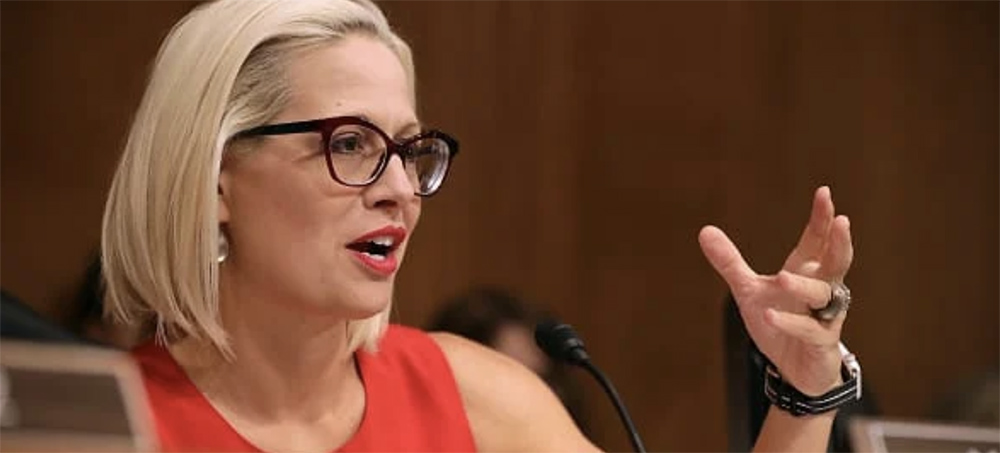 Kyrsten Sinema. (photo: Chip Somodevilla/Getty Images)
Kyrsten Sinema. (photo: Chip Somodevilla/Getty Images)
In a statement after a Saturday meeting, the Arizona Democratic Party State Committee said the Democratic Party was at a "critical crossroads" and could lose both the House and Senate in the 2022 midterm elections if legislation is not passed on issues including voting rights, healthcare and immigration.
It noted that an overwhelming 91 percent of committee members had called for an immediate elimination of the Senate filibuster—which the committee branded a "Jim Crow relic"—in May.
But Sinema, a Democrat, has maintained her ironclad commitment to preserving it despite ongoing appeals from local and national leaders, as well as months of protests and two sit-ins outside her office, it adds.
She has long maintained that the filibuster forces Republicans and Democrats to work together.
"Senator Sinema remains steadfast in her support for the filibuster, does not support much of President Biden's Build Back Better Agenda and does not support the platform of the Arizona Democratic Party," the statement continued.
"On a Zoom call with the ADP Executive board, she disregarded appeals of our leaders doubling down on her factually contrary 'we need bipartisanship' argument for keeping the filibuster and has failed to hold a single northern, southern or central town hall with the citizens of Arizona."
It went on: "While we want Senator Sinema to be SUCCESSFUL, her argument that the filibuster protects the rights of minorities has become laughable in the face of Republican state legislators' actions on voting rights, public health during the pandemic and abortion rights."
The committee added that the Arizona Democratic Party will closely monitor Sinema's votes in the coming weeks.
If she does not vote in favor of filibuster reform, the $3.5 trillion budget reconciliation bill and the American Families Plan, the committee says it will press forward with a no confidence vote.
"If she continues to delay, disrupt, or vote to gut the Reconciliation Package of its necessary funding," the statement said, "then the Arizona Democratic Party State Committee will go officially on record and will give Senator Sinema a vote of NO CONFIDENCE."
Sinema has said she would not vote in support of Democrats' $3.5 trillion infrastructure plan, which its considered an important part of President Joe Biden's and congressional Democrats' agenda leading into next year's midterms.
"While I support beginning this process, I do not support a bill that costs $3.5 trillion," she said.
Kai Newkirk, a progressive organizer in Arizona, tweeted that Sinema was "setting her political future on fire" by obstructing the agenda that Democrats were elected to deliver. "If she doesn't change course drastically and soon, it will be too late," Newkirk tweeted.
Sinema's office has been contacted for comment.
 SPD supporters and members cheer at the election party of the Berlin SPD after the first forecasts for the outcome of the elections to the House of Representatives were announced, in Berlin, Sunday, Sept. 26, 2021. (photo: Bernd Von Jutrczenka/dpa/AP)
SPD supporters and members cheer at the election party of the Berlin SPD after the first forecasts for the outcome of the elections to the House of Representatives were announced, in Berlin, Sunday, Sept. 26, 2021. (photo: Bernd Von Jutrczenka/dpa/AP)
The Social Democrats’ candidate Olaf Scholz, the outgoing vice chancellor and finance minister who pulled his party out of a years-long slump, said the outcome was “a very clear mandate to ensure now that we put together a good, pragmatic government for Germany.”
Despite getting its worst-ever result in a federal contest, the Union bloc said it too would reach out to smaller parties to discuss forming a government, while Merkel stays on in a caretaker role until a successor is sworn in.
Election officials said early Monday that a count of all 299 constituencies showed the Social Democrats received 25.9% of the vote, ahead of 24.1% for the Union bloc. No winning party in a German national election had previously taken less than 31% of the vote.
Armin Laschet, the governor of North Rhine-Westphalia state who outmaneuvered a more popular rival to secure the nomination of Merkel’s Union bloc, had struggled to motivate the party’s base and suffered a series of missteps.
“Of course, this is a loss of votes that isn’t pretty,” Laschet said of results that looked set to undercut by some measure the Union’s previous worst showing of 31% in 1949. But he added that with Merkel departing after 16 years in power, “no one had an incumbent bonus in this election.”
Laschet told supporters that “we will do everything we can to form a government under the Union’s leadership, because Germany now needs a coalition for the future that modernizes our country.”
Both Laschet and Scholz will be courting the same two parties: the environmentalist Greens, who were third with 14.8%; and the pro-business Free Democrats, who took 11.5% of the vote.
The Greens traditionally lean toward the Social Democrats and the Free Democrats toward the Union, but neither ruled out going the other way.
The other option was a repeat of the outgoing “grand coalition” of the Union and Social Democrats that has run Germany for 12 of Merkel’s 16 years in power, but there was little obvious appetite for that after years of government squabbling.
“Everyone thinks that … this ‘grand coalition’ isn’t promising for the future, regardless of who is No. 1 and No. 2,” Laschet said. “We need a real new beginning.”
The Free Democrats’ leader, Christian Lindner, appeared keen to govern, suggesting that his party and the Greens should make the first move.
“About 75% of Germans didn’t vote for the next chancellor’s party,” Lindner said in a post-election debate with all parties’ leaders on public broadcaster ZDF. “So it might be advisable … that the Greens and Free Democrats first speak to each other to structure everything that follows.”
Baerbock insisted that “the climate crisis … is the leading issue of the next government, and that is for us the basis for any talks … even if we aren’t totally satisfied with our result.”
While the Greens improved their support from the last election in 2017, they had higher expectations for Sunday’s vote.
The Left Party was projected to win only 4.9% of the vote and risked being kicked out of parliament entirely. The far-right Alternative for Germany — which no one else wants to work with — received 10.3%. This was about 2 percentage points less than in 2017, when it first entered parliament.
Due to Germany’s complicated electoral system, a full breakdown of the result by seats in parliament was still pending.
Merkel, who has won plaudits for steering Germany through several major crises, won’t be an easy leader to follow. Her successor will have to oversee the country’s recovery from the coronavirus pandemic, which Germany so far has weathered relatively well thanks to large rescue programs.
Germany’s leading parties have significant differences when it comes to taxation and tackling climate change.
Foreign policy didn’t feature much in the campaign, although the Greens favor a tougher stance toward China and Russia.
Whichever parties form the next German government, the Free Democrats’ Lindner said it was “good news” that it would have a majority with centrist parties.
“All of those in Europe and beyond who were worried about Germany’s stability can now see: Germany will be stable in any case,” he said.
Spanish Prime Minister Pedro Sanchez sent early congratulations to Scholz.
“Spain and Germany will continue to work together for a stronger Europe and for a fair and green recovery that leaves no one behind,” he wrote on Twitter.
In two regional elections also held Sunday, the Social Democrats looked set to defend the post of Berlin mayor that they have held for two decades. The party was also on course for a strong win in the northeastern state of Mecklenburg Western-Pomerania.
For the first time since 1949, the Danish minority party SSW was set to win a seat in parliament, officials said.
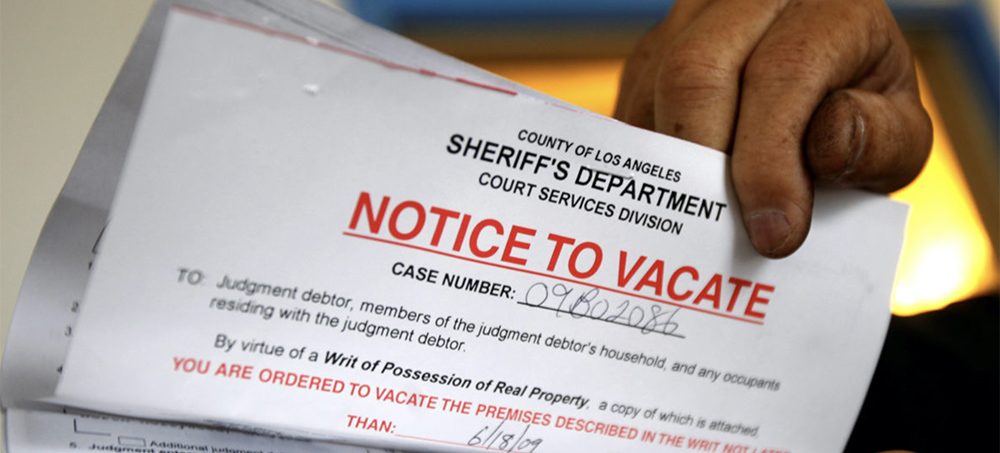 The eviction ban is ending. (photo: AP)
The eviction ban is ending. (photo: AP)
The high court’s conservative majority late Thursday blocked the Biden administration from enforcing a temporary ban placed because of the coronavirus pandemic. The action ends protections for about 3.5 million people in the United States who say they faced eviction in the next two months, according to U.S. Census Bureau data from early August.
“We are incredibly disappointed in the Supreme Court ruling and ask Congress and Governor (Doug) Ducey to take action to prevent what will likely be tragic outcomes for thousands of Arizona families,” said Cynthia Zwick, executive director of the nonprofit organization Wildfire that is helping distribute government rental assistance in Arizona.
“Lives are literally at risk as the pandemic continues to surge and families lose their homes, especially during this time of extreme heat,” she said, referring to Phoenix’s triple-digit temperatures.
Wildfire is encouraging tenants to keep applying for rental aid and “work with their landlords to develop plans for making payments until the assistance is available,” she said.
But some local officials around the U.S. say the court’s action is unlikely to set off the flood of evictions some advocates predict.
Scott Davis, spokesman for the Maricopa County Justice Courts that handle the bulk of Arizona’s evictions, said he does not expect anything overly dramatic overnight. He said how things play out will depend on how landlords and their attorneys decide to handle cases and that the courts were well prepared for whatever happens.
“We know that eviction case filings over the last 17 months are down about 50% from pre-pandemic,” Davis said. “Will filings bounce back to 100% of the norm? Will they exceed the norm to make up for filings which landlords withheld during the pandemic? Some believe there will be a large flood of case activity; others believe it will be just a light sprinkle, which builds gradually over time. Again — it’s up to landlords.”
Davis emphasized no one can be evicted immediately without due process, and the cases could take weeks to be carried out in the courts.
The Apartment Association of Southeastern Wisconsin said Friday that landlords rarely evict anyone who is only a few hundred dollars behind on rent. It said the average eviction judgment for unpaid rent in Wisconsin is more than $2,600.
“Contrary to dire predictions by tenant advocates, there will NOT be a ‘tsunami’ of eviction filings in Wisconsin or in most parts of the country,” the landlord trade association said. “There will NOT be 11 million people suddenly made homeless.”
The court’s action does not affect the temporary bans on evictions placed by a handful of states, including California.
“California’s eviction protections remain in place through September 30, with additional protections through March of 2022 for people who apply for rent relief,” said Russ Heimerich, spokesman for the state’s housing agency.
The high court’s move wasn’t a huge surprise. The justices had allowed an earlier pause on lockouts to continue through July, but they hinted in late June they would take this path if asked again to intervene. The moratorium had been scheduled to expire Oct. 3.
The court said in an unsigned opinion that the U.S. Centers for Disease Control and Prevention, which reimposed the moratorium Aug. 3, lacked the authority to do so under federal law without explicit congressional authorization. The three liberal justices dissented.
White House press secretary Jen Psaki said President Joe Biden “is once again calling on all entities that can prevent evictions — from cities and states to local courts, landlords, Cabinet Agencies.”
Congress is on recess for a few weeks and is unlikely take immediate action on legislation.
But key progressive lawmakers Friday urged House Speaker Nancy Pelosi and Senate Majority Leader Chuck Schumer, the Democratic leaders, to consider passing legislation to extend the moratorium during the pandemic.
One option would be to include an evictions measure in the upcoming budget infrastructure packages that Congress will consider when lawmakers return in September.
“The impending eviction crisis is a matter of public health and safety that demands an urgent legislative solution to prevent further harm and needless loss of human life,” read the letter from Reps. Ayanna Pressley, D-Massachusetts, Cori Bush, D-Missouri, Jimmy Gomez, D-California, and Alexandria Ocasio-Cortez, D-New York. It was signed by 60 lawmakers.
Pelosi said Friday the House “is assessing possible legislative remedies.”
Congress has approved more than $46.5 billion in rental assistance, but so far state and local governments have distributed 11% of that money, just over $5 billion, the Treasury Department said Wednesday.
Landlord organizations blamed the slow rollout on aid qualification requirements imposed by Congress that many applicants find cumbersome.
Courtney Gilstrap LeVinus, president and CEO of the Arizona Multihousing Association, said many mom-and-pop rental owners have been pushed to the brink of bankruptcy, with about $500 million in rent unpaid statewide.
“Despite such intense financial pressure, Arizona property owners have worked with residents to keep them in their homes, to keep them safe from the pandemic, and to help them qualify for eviction relief that has been slow to arrive for a year and a half,” LeVinus said. “We have strongly encouraged our members to keep working with residents to avoid evictions in every possible instance.”
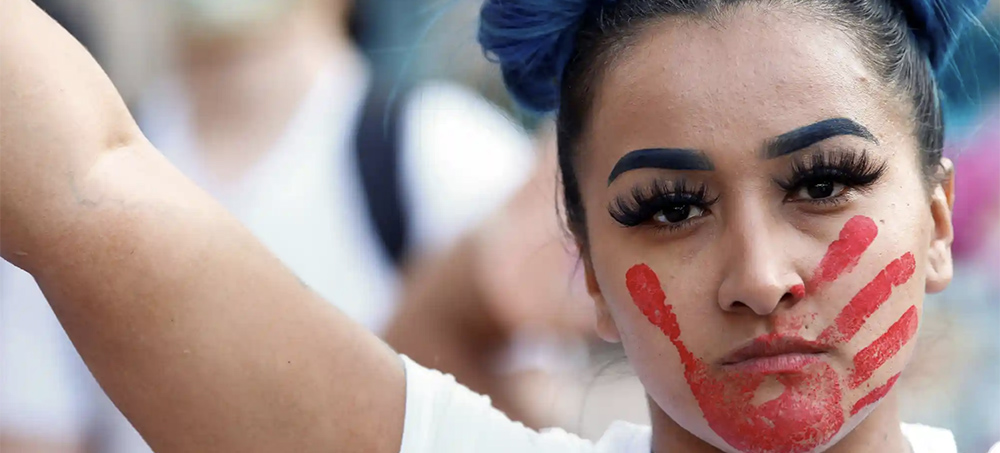 A woman with a red hand painted on her face, which calls attention to the high rates of Indigenous women who are murdered or missing. (photo: Kevin Mohatt/Reuters)
A woman with a red hand painted on her face, which calls attention to the high rates of Indigenous women who are murdered or missing. (photo: Kevin Mohatt/Reuters)
The death of Gabby Petito draws attention to a form of widespread gendered violence in the US that has long been hiding in plain sight
Her boyfriend, Matthew Lewinski, immediately admitted to the police he strangled her last December, keeping her mutilated body in the basement of the home they shared for months.
The same week, down in Starkville, Mississippi, William Chisholm was convicted of capital murder in the death of his ex-girlfriend Dr Shauna Witt. One month following her breaking up with him, Chisholm stormed the Walmart eye clinic where Witt worked as an optometrist and shot her dead.
Over in Baltimore, Maryland, Gomezgeka Chisala was that same week being held without bail after confessing to the killing of his ex-girlfriend Shaunya Green, a life-loving nurse and mother of two who once traveled to Africa to walk among elephants. Earlier in the month, Chisala had driven to Green’s home with a gun, entered into an argument with her and shot her dead.
Year after year, FBI statistics on nationwide homicides reveal that a vast proportion of women killed in the US are killed by current or former intimate partners. According to the CDC, homicide is the fourth leading cause of death for girls and women one to 19 years old, and the fifth leading cause of death for women 20 to 44.
The heart-wrenching confirmation that the remains of Petito had been found in Wyoming, and the search for Laundrie, deemed a “person of interest” in what has now been ruled a homicide, begs for scrutiny not only the circumstances of Petito’s devastating disappearance, but draws sorely needed attention to a form of widespread gendered deadly violence in the US that has long been hiding in plain sight.
According to analysis of FBI data, of all female homicides accounted for in 2018 where the relationship between perpetrator and victim could be identified, 92% of cases involved women or girls killed by a man they knew, 63% of whom were killed by current husbands, ex-husbands or current boyfriends.
This puts confirmed American female intimate gendered killings happening at a staggering rate of almost three women every day. Those circumstances are drastically different to men’s, who are killed by other men in three quarters of cases, and in over a quarter of cases by strangers.
Yet this particularity – and predictability – receives barely any attention domestically.
While in France, the word femicide, or féminicide, is now used as a way of describing the epidemic of women killed by men in intimate settings, the term is barely understood outside of niche circles in the US. This, in spite of the fact that there are 10 times more women killed in this way in this country than in France (1,014 confirmed intimate acquaintance killings of women in the US in 2018 compared to 120 that same year in France). Adjusting for population size, the problem is twice as bad in the US than it is in France.
In Turkey, where so-called “honor killings” are reportedly still practiced, and where the murder of a 27-year-old woman by her ex-boyfriend last summer sparked globally-covered protests, the rate of women killed is also below that of the US. There, 474 women were killed in 2019, compared to 2,991 women in the same year here. Even accounting for the fact that the US is four times larger in population than Turkey, the proportion of femicides here remains distinctly larger.
When Americans do recognize the term femicide, they often think of it as a problem happening in other countries, or in already marginalized communities at home.
There is some merit to those thoughts. According to the National Indigenous Women’s Resource Center, the homicide rate for Indigenous women and girls in the US is six times higher than it is for white women and girls, and 94% of cases are attributable to former or current partners. But the severity of this mostly flies under the radar. Half of Indigenous homicide reports are missing from FBI data, the center says, meaning many lives lost are ignored in much of the official counting.
When Indigenous women are reported missing, less effort is put into finding them across the board, numbers suggest. In Wyoming, where the remains of Petito were found eight days after she was reported missing, white people are found in 81% of cases after a week of being declared missing, compared to only 61% of Indigenous people in the same timeframe – a difference of 20%.
Laws protecting Indigenous rights in the US, which gives power to tribal courts and federal courts, but not state courts, can complicate matters too.
At the end of 2019, two months after 17-year-old Faith Lindsey went missing in Pauls Valley, Oklahoma, her boyfriend, Tanner Washington, was arrested for first-degree murder by local authorities after being found with Lindsey’s blood on his shoes, pants and phone. But charges were later dismissed because of the alleged crime happening on tribal land.
While federal charges were brought this year, the trial has yet to happen, and Faith’s body was never found – meaning she is yet another Indigenous woman unaccounted for in official femicide counts while her family awaits answers.
“It’s a hard time because not knowing where she’s at, not knowing if she’s still here or if she’s gone. We don’t know,” her sister Justice said last fall.
While nationwide homicide data for 2020 and 2021 have yet to be released, anecdotal evidence suggests the problem got worse during the lockdowns associated with the Covid-19 epidemic.
Scott Colom, a district attorney in north-east Mississippi, tells me there has been an undeniable uptick in domestic violence incidents. In the last four months alone, in the relatively small four-county area he serves, where the population is about 140,000, three Black women have been killed, with current or former intimate partners facing charges. Their names were Lisa Brooks, Whitney Taylor and Kaliyah Brooks.
Of all the women captured in FBI homicide data, Black women and girls are being murdered by male offenders at a rate of almost three times more than white women.
Colom says part of the problem is how the system addresses daily occurrences of domestic violence incidents before they turn lethal. He explains that with the strengthening of violence against women laws, including mandatory arrest laws, arrests are almost certain when someone is accused of domestic violence. But as the system focuses on arrests, charges and convictions, the victim’s needs and wishes are paradoxically often brushed to the side.
As things stand, after a complaint or an arrest, there is no formal follow-up with an accuser, and in the months in between an arrest being made and them being bid to court, the accuser has very often dropped charges. This happens because the accuser may rely on the accused for money or housing, because he may be the father of her children, or because she is emotionally attached to him and doesn’t want to be the cause for him going to jail.
This week, a middle-aged woman ended up in hospital having to undergo surgery in one of the counties Colom serves after her husband beat her with a crowbar. She was able to call her son during the incident to help de-escalate, but when investigators talked to her, she explained leaving him was not an option. She understood her husband was a threat to her, but she needed him to pay rent and couldn’t afford a divorce.
“This is a huge problem in our system: that we are not equipped to give her what we need for her to feel safe, and for her to have the ability to get away from this guy. There needs to be a lot more support for women who are victims of domestic abuse to help them get out of their situation,” Colom says, adding that domestic violence response is “one of the worst things we are doing in this system”.
Sarah Fair George, a state’s attorney in Vermont who serves a majority white, mostly middle-class constituency, explains that while domestic violence is one of their most common charges, it is also among the most complicated.
“The dynamic of intimate partner violence is by its very name intimate. So there are very rarely witnesses, very rarely corroborating evidence. There’s the complicated factor of control and manipulation, financial dependence, isolation – all of those types of things that come from being in an abusive relationship that make the proving something beyond a reasonable doubt difficult,” George says.
When considering reporting intimate partner violence, these factors play into account in accusers’ minds who may be reluctant to either denounce or follow through on an accusation, while the person committing violence might take advantage of these factors, with the situation escalating.
“That’s why so many ultimately end up in this extreme of homicide. Because there’s build up over time behind these closed walls. The person gets more and more violent without any intervention and it ends up being fatal.”
George says it is “alarming” to her that while Vermont’s homicide rate is consistently in the single digits every year, she can think of three incidents of women being killed by current or former intimate partners in the last couple of years in her county alone.
She believes a more holistic approach is needed: one that would spend more time and resources on addressing the root problem, discouraging recidivism and truly listened to victims.
Colom agrees: advocating for a more reparative system in which counsellors would meet with victims, assess needs and wishes and provide immediate access to material support – including housing, money, or jobs. If women decided to stay, a more reparative system would focus on making the landing as safe as possible, working with men towards growth and change.
But there is barely any funding for these types of services – just federal funding for arrests and convictions.
The other, essential and consistently missing part of the puzzle precedes physical violence, and has more to do with power, and male entitlement over women.
“Historically, there’s been a problem with how men have been taught to view women. And some of that manifests itself in what we see with these murders,” says Colom, who was the prosecutor in the case of the Walmart fatal shooting of the optometrist that involved two middle-class white people, and is quick to point out that “toxic masculinity does not know class, that’s for sure”.
“What I see is that they are treating women like their property. Like, ‘This person belongs to me. If I can’t have her, nobody can have her. If I am not happy, it’s her fault.’ It’s a frame of mind of toxic masculinity that I see all the time,” Colom says.
Teaching men to get out of this frame of mind is crucial. Without doing this, we are left living in a country that has silently accepted femicide as a byproduct of its structure – to the extent that it doesn’t even bother naming it.
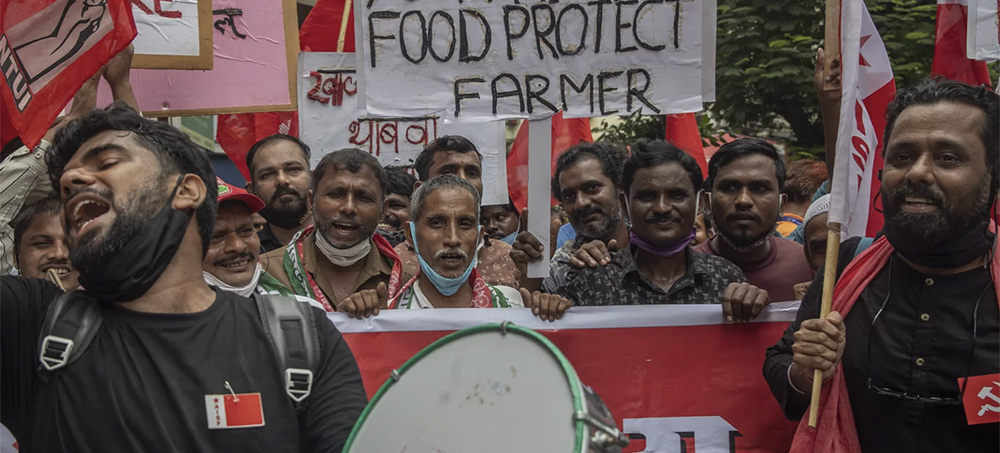 Members of Communist Party of India shout slogans during a protest against farm laws in Mumbai, India Monday, Sept. 27, 2021. The farmers called for a nation-wide strike Monday to mark one year since the legislation was passed, marking a return to protests that began over a year ago. (photo: Rafiq Maqbool/AP)
Members of Communist Party of India shout slogans during a protest against farm laws in Mumbai, India Monday, Sept. 27, 2021. The farmers called for a nation-wide strike Monday to mark one year since the legislation was passed, marking a return to protests that began over a year ago. (photo: Rafiq Maqbool/AP)
The farmers have renewed their protests with calls for a nationwide strike on the anniversary of the legislation's passage. The drawn-out demonstrations have posed one of the biggest political challenges to Prime Minister Narendra Modi, who swept the polls for the second time in 2019.
Waving colorful flags and distributing free food, hundreds of farmers gathered Monday at one of the protest sites on the edges of the capital, New Delhi.
"The enthusiasm we had on the first day, it is much stronger and bigger now," said Manjit Singh, a 45-year-old farmer and protester.
Mohini Kaur, a 61-year-old New Delhi resident traveled to the protest site to show her support for the farmers.
"These lion-hearted farmers are here today under the hot sun. They have been exposed to rain, heat and the cold," she said.
Protesters expressed their determination to keep the movement going — some even brought mattresses with them, camping out as the day went on.
Along New Delhi's southwest and eastern fringes, protesting farmers crowded highways, choking traffic and cutting off access from the capital to neighboring states. Police were deployed to three main protest sites on the outskirts of the city to maintain law and order.
A coalition of farmers' unions — known as the Samyukta Kisan Morcha, or United Farmers' Front — has called on shops, offices, factories and other institutions to shut their doors in solidarity for the 10-hour strike. The calls for a strike, however, seemed to go largely unanswered, with most businesses continuing work as usual across the capital.
The government has defended the legislation, saying it is necessary to modernize agriculture and that the laws will boost production through private investment. But the farmers say the new legislation will devastate their earnings by ending guaranteed pricing and force them to sell their crops to corporations at cheaper prices.
In neighboring Punjab and Haryana states — which are the country's the two biggest agricultural producers — thousands of demonstrators also blocked highways, bringing traffic to a halt in some areas.
In the eastern state of Bihar, trains were halted as farmers squatted on railway tracks. Protesters also took to the streets, raising slogans against the Modi government, burning tires and blocking roads across the region. Police said some 500 protesters had been taken into custody, but added that the shutdown remained peaceful.
In the southern city of Bengaluru on Monday, hundreds of people marched in support of the protest against the government. In the southern state of Kerala, the ruling Left Democratic Front called for a total shutdown, reported local media.
Opposition parties in India, including the Congress Party, have supported the farmers. Senior leader Rahul Gandhi called the government "exploitative" and said he stood with farmers on Monday.
A number of talks between the government and farmers have failed to resolve the issue.
In November, the farmers escalated their movement by hunkering down on the outskirts of New Delhi, where they have camped out for nearly a year, pushing through a harsh winter as well as a coronavirus surge that devastated India earlier this year.
While the farmers' protest movement has been largely peaceful, demonstrators in January broke through police barricades to storm the historic Red Fort in the capital's center. Clashes with police left one protester dead and hundreds injured.
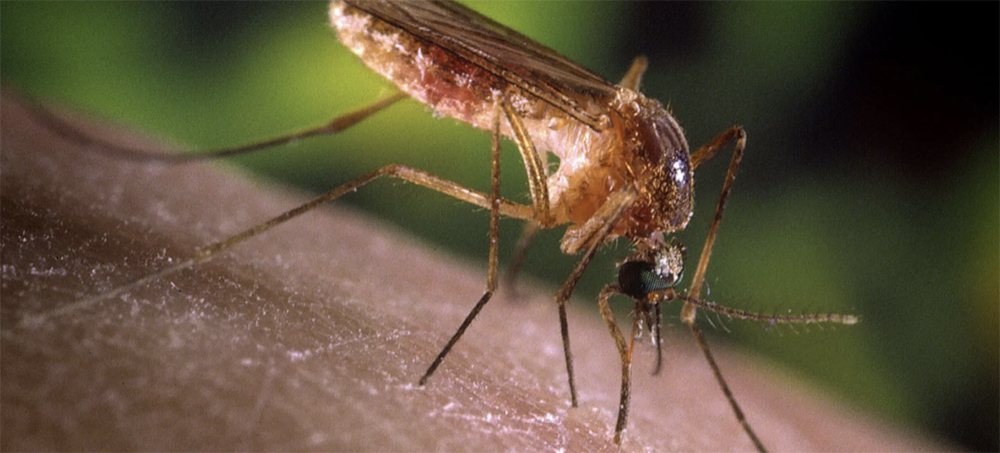 A mosquito. (photo: Smith Collection/Gado/Getty Images)
A mosquito. (photo: Smith Collection/Gado/Getty Images)
Thanks to climate-fueled extreme weather, mosquitoes are everywhere this year.
It was an unusually warm summer — the hottest summer on record for the contiguous United States — and that has helped mosquitoes thrive. But experts say the chief reasons for the explosion in mosquito populations this year are the season’s record-breaking storms and above-average rainfall in many states.
Parts of the Northeast received a foot of rain in just three weeks in July, due to a series of back-to-back thunderstorms and the remnants of Hurricane Elsa. In August, Tropical Storm Fred and its remnants doused the East Coast from Florida to Massachusetts, and Tropical Storm Henri hit New England head on. Less than two weeks later, Ida soaked the Gulf Coast as a Category 4 and blasted the Northeast with record-breaking amounts of rainfall as a disorganized storm system. Meanwhile, in the Southwest, a “super” monsoon season eased drought conditions in parts of Arizona, producing Tuscon’s wettest month on record in July.
Climate change plays a role in exacerbating these storms. The air becomes 4 percent more saturated with water for every 1 degree Fahrenheit that the planet warms. The most torrential downpours in the Northeast now unleash 55 percent more rain compared to the 1950s, according to the most recent National Climate Assessment, and could increase another 40 percent by the end of the century.
Unfortunately for humans, the abundance of mosquitoes varies massively with rainfall. The more rain there is, the more scattered pools of water there are across the landscape that the insects can use to lay their eggs in. This summer’s rains basically turned half of the U.S. into a perfect breeding ground for mosquito larvae.
“The mosquito is the state bird of New Jersey,” Andrew Dobson, a professor of ecology and evolutionary biology at Princeton University, told Grist. “But this year seems much worse than normal.”
It’s early to say how, exactly, this year stacks up to previous years in terms of mosquito populations. But the uptick in mosquitoes has been clocked by experts and officials in multiple states so far.
“This is actually one of the worst mosquito seasons in recent memory with a record number of the bugs plaguing communities across New York,” Senator Chuck Schumer, Democrat from New York, said at a press conference over the weekend. He called on federal agencies to make funds available to New York to fight off the invasion. In Luzerne County, Pennsylvania, officials told a local news station that 2021 has brought more mosquitoes to their county than they’ve seen in the past decade. In New Orleans, city officials reported more mosquitoes than usual, and nearby St. Tammany Parish reported a 300 percent increase in two types of mosquitoes. Steven Oscherwitz, an infectious disease specialist in Arizona, told Grist that he’s seen an increase in mosquitoes in the Southwest, too, due to the extremely heavy monsoon season. Even Southern California is seeing more mosquitoes than usual, due not to rain but to heat and humidity.
Some of those mosquitoes are more than just a nuisance. The Culex genus of mosquito carries West Nile virus, a disease in the Yellow Fever family that causes no symptoms in most people but severe disease — including high fever, headaches, tremors, paralysis, and even death — in older and immuno-compromised people. Multiple state public health departments have issued warnings about West Nile virus in recent weeks. Arizona, Arkansas, California, Idaho, New Jersey, and Texas have each reported one to two deaths related to the disease so far, and many more states have recorded human cases of West Nile.
West Nile virus is relatively new to the U.S., as far as vector-borne diseases go. The first cases were reported roughly 20 years ago. The illness has no cure, and there is no vaccine available to prevent infection. But Dobson, from Princeton, said that many Americans have immunity to West Nile without knowing it, because they’ve been exposed to bites from mosquitos carrying the virus for multiple summers in a row. The COVID-19 pandemic, however, may have contributed to decreased immunity this year, Dobson hypothesized, because people were stuck inside last summer and weren’t getting bitten as much, leading to a drop in the number of people getting immunity from the virus last year. “You might expect to see more cases of West Nile because people have been isolating themselves because of COVID,” Dobson said.
Climate change has helped mosquitos carrying West Nile and other diseases like malaria and dengue fever move around to new and higher ground, where warmer temperatures are helping the insects survive and bite humans. And higher temperatures can also affect the quantity of virus the mosquitos carry, Oscherwitz said. “When it’s really hot, the West Nile virus can multiply in them more, so they each carry a higher load of that virus than they would if we had cooler weather,” he said.
The impact of climate change on vector-borne disease more generally has experts worried. “We’ve got to be thinking much more cogently about planet change and what we’re going to do to stop it,” Dobson said. “Otherwise we’re going to have more floods, more diseases.”
Follow us on facebook and twitter!
PO Box 2043 / Citrus Heights, CA 95611



No comments:
Post a Comment